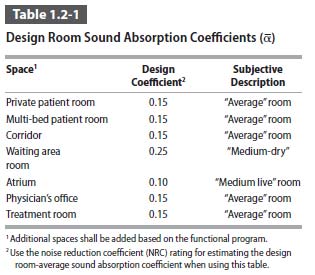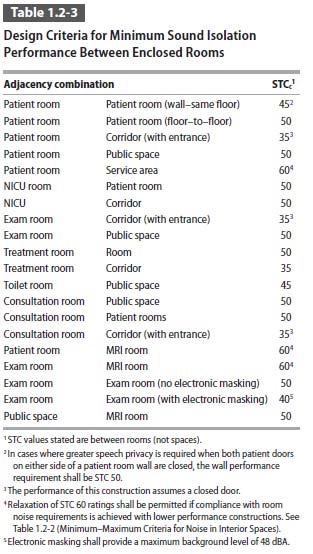Acoustic Ratings and Privacy Specifications
Design of Hospital Rooms

When selecting materials to construct or modify hospital rooms and ceilings, an important factor in their selection is their ability to absorb or block sound.
 There are three main aspects to sound or noise: its source (people, equipment, ‘outside’ noises, etc.), its receiver (other people), and its path (how noise gets from the source to the receiver). Background noise tolerance varies based on the specifications of each room. For example, patient rooms have different rating from teleconferencing rooms. In addition to noise, speech privacy is also an important aspect to take into consideration. Privacy is measured in terms of Articulation Index (0 to 1.0), Privacy Index (0% to 100%) Speech Transmission Index, and Speech Intelligibility Index. Normal rooms have different rating and needs from confidential rooms, which include admitting areas, exam rooms, hematology labs, psychiatric and physiological testing rooms and areas where patients discuss their personal health. (TABLE 1.2-1)
There are three main aspects to sound or noise: its source (people, equipment, ‘outside’ noises, etc.), its receiver (other people), and its path (how noise gets from the source to the receiver). Background noise tolerance varies based on the specifications of each room. For example, patient rooms have different rating from teleconferencing rooms. In addition to noise, speech privacy is also an important aspect to take into consideration. Privacy is measured in terms of Articulation Index (0 to 1.0), Privacy Index (0% to 100%) Speech Transmission Index, and Speech Intelligibility Index. Normal rooms have different rating and needs from confidential rooms, which include admitting areas, exam rooms, hematology labs, psychiatric and physiological testing rooms and areas where patients discuss their personal health. (TABLE 1.2-1)

To prevent unwanted noise from spreading, rooms can be constructed with materials that prevent noise from traveling along its path from source to receiver, either by directly absorbing the noise or otherwise blocking its path. The Noise Reduction Coefficient (NRC) measures a material’s ability to absorb sound, measured as a percentage between 0.0 (0%) and 1.0 (100%). To be considered an excellent sound absorber, a material must achieve an NRC rating of greater than 0.80 (80%). The Sound Absorption Coefficient (ᾱ) indicates the fraction of incident sound energy absorbed, and is again measured from 0.0 (0%) and 1.0 (100%). (TABLE 1.2-1)As an alternative to absorbing sound, materials can be selected based on their performance in blocking sound. To be considered a high performance sound block, a partition must achieve a lab rating of equal to or greater than 55 in a Sound Transmission Class (STC). Height, thickness, and insulation of a wall or partition can directly impact its STC rating (PICTURES AND TABLE 1.2-3).
Ceilings can also block sound, and are important for ensuring that sound from one room does not enter into an adjacent room. A Ceiling Attenuation Class (CAC) of greater than 35 indicates a high performance sound block, and a value of 40 is considered the onset of acoustical ‘privacy’. However, in practice, ceilings are given an Apparent Sound Transmission Class (a field rating) that is typically 5-8 points lower than its STC rating under laboratory conditions. The best combination for a ceiling is a combination of high CAC and high NRC. This can be achieved via Ultima mineral fiber panels (NRC=0.70-0.80; CAC=35-40) and Optima fiberglass panels (NRC=0.90-1.00; CAC=26).